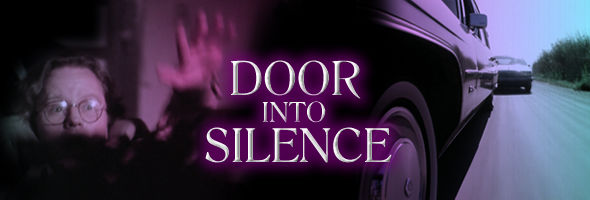
Color, 1991, 86m.
Directed by Lucio Fulci
Starring John Savage, Sandi Schultz, Richard Castleman, Jennifer Loeb
Severin (DVD) (US R1 NTSC)

Color, 1991, 86m.
Directed by Lucio Fulci
Starring John Savage, Sandi Schultz, Richard Castleman, Jennifer Loeb
Severin (DVD) (US R1 NTSC)
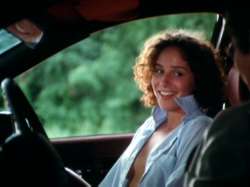 Suspense and horror directors have a funny way of closing out their careers. Alfred Hitchcock turned out the decidedly family-friendly and bloodless Family Plot before his death, and Lucio Fulci, the master of shambling zombies and psychedelic thrillers, bid adieu to his fans with the likewise bloodless and oddly ethereal Door into Silence (with the film's credits listing the director as "H. Simon Kittay" for some reason). The film was financed by Joe D'Amato's s short-lived Filmirage, a company better known for Stage Fright, Witchcraft, and, uh, Troll 2. This film, Fulci's only for the company, came near its final days, and D'Amato was fond of lensing softcore films in New Orleans like Any Time, Any Play. Of course, this was also Fulci's old stomping grounds from The Beyond, and a modest, peculiar supernatural quickie was born.
Suspense and horror directors have a funny way of closing out their careers. Alfred Hitchcock turned out the decidedly family-friendly and bloodless Family Plot before his death, and Lucio Fulci, the master of shambling zombies and psychedelic thrillers, bid adieu to his fans with the likewise bloodless and oddly ethereal Door into Silence (with the film's credits listing the director as "H. Simon Kittay" for some reason). The film was financed by Joe D'Amato's s short-lived Filmirage, a company better known for Stage Fright, Witchcraft, and, uh, Troll 2. This film, Fulci's only for the company, came near its final days, and D'Amato was fond of lensing softcore films in New Orleans like Any Time, Any Play. Of course, this was also Fulci's old stomping grounds from The Beyond, and a modest, peculiar supernatural quickie was born.
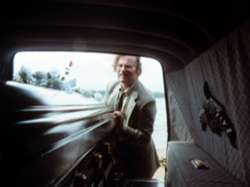 While driving through Louisiana, Melvin Devereux (Savage) passes a funeral where his last name is prominently on display. He becomes more alarmed when he sees that the body bears a striking resemblance to him, and that night he encounters a beautiful but spooky woman (Schultz) who helps him find an auto repair shop. As he passes further away from the city, he repeatedly becomes involved in a Duel-esque game of cat and mouse with a slow-moving hearse whose creepy driver (Castleman, D'Amato's location scouter) won't let him pass. A colorful gallery of characters also passes through, including a hot-to-trot teenager trying to get to Memphis for the "Country Music Festival" ("Randy Travis! Tammy Wynette! It's gonna be great!") and offers to sleep with him for fifty bucks.A ter a particularly nasty phone call involving a tarot reader, Melvin finally reaches his destiny involving the hearse and a particularly fateful sunset.
While driving through Louisiana, Melvin Devereux (Savage) passes a funeral where his last name is prominently on display. He becomes more alarmed when he sees that the body bears a striking resemblance to him, and that night he encounters a beautiful but spooky woman (Schultz) who helps him find an auto repair shop. As he passes further away from the city, he repeatedly becomes involved in a Duel-esque game of cat and mouse with a slow-moving hearse whose creepy driver (Castleman, D'Amato's location scouter) won't let him pass. A colorful gallery of characters also passes through, including a hot-to-trot teenager trying to get to Memphis for the "Country Music Festival" ("Randy Travis! Tammy Wynette! It's gonna be great!") and offers to sleep with him for fifty bucks.A ter a particularly nasty phone call involving a tarot reader, Melvin finally reaches his destiny involving the hearse and a particularly fateful sunset.
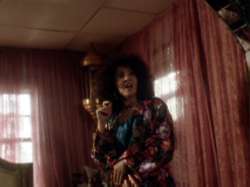 here shouldn't stop any of his fanatics from seeking this one out. The arty, meandering tone of the story is offset by a strong, paranoid, somewhat Brad Dourif-like performance by the still-busy Savage (definitely the biggest name Fulci had in the second half of his career), and his decision to shoot on the obscure backroads of Louisiana rather than the familiar tourist areas makes for much more visual interest than usual for the area. Of course, this also means some weird, stilted performances by some of the locals who were apparently non-actors recruited on the spot (check out the two cops), and the one-off score by Franco Piana veers wildly from jazz to thunking suspense cues, with some uncredited filler dropped in from the score to Stage Fright. Incredibly, this was the first Fucli score released in its entirely on CD, while the film itself was barely distributed at all, popping up most widely as a Japanese VHS which barely made a blip on the bootleg market.
here shouldn't stop any of his fanatics from seeking this one out. The arty, meandering tone of the story is offset by a strong, paranoid, somewhat Brad Dourif-like performance by the still-busy Savage (definitely the biggest name Fulci had in the second half of his career), and his decision to shoot on the obscure backroads of Louisiana rather than the familiar tourist areas makes for much more visual interest than usual for the area. Of course, this also means some weird, stilted performances by some of the locals who were apparently non-actors recruited on the spot (check out the two cops), and the one-off score by Franco Piana veers wildly from jazz to thunking suspense cues, with some uncredited filler dropped in from the score to Stage Fright. Incredibly, this was the first Fucli score released in its entirely on CD, while the film itself was barely distributed at all, popping up most widely as a Japanese VHS which barely made a blip on the bootleg market.
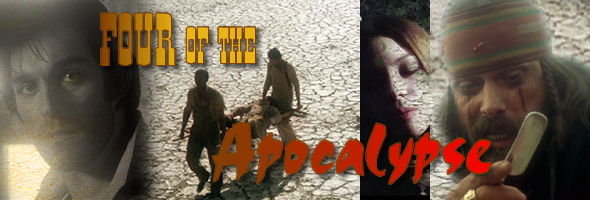
Color, 1975, 104 mins.
Directed by Lucio Fulci
Starring Fabio Testi, Lynne Frederick
Anchor Bay (US R1 NTSC) / WS (1.85:1) (16:9)
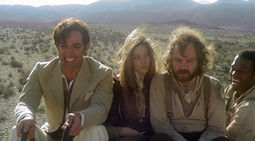 Fabio Frizzi and cinematographer Sergio Salvati, demonstrate how significant their contributions were even this early in the game, and for once, Fulci seems to be engaged enough in the proceedings to experiment with his visuals and narrative form in some unexpected ways. Though possibly a difficult place to start for newcomers, Apocalypse is a must see for Fulci fanatics and proves once again that his grisly excesses were grounded in a firm stylistic approach.
Fabio Frizzi and cinematographer Sergio Salvati, demonstrate how significant their contributions were even this early in the game, and for once, Fulci seems to be engaged enough in the proceedings to experiment with his visuals and narrative form in some unexpected ways. Though possibly a difficult place to start for newcomers, Apocalypse is a must see for Fulci fanatics and proves once again that his grisly excesses were grounded in a firm stylistic approach.
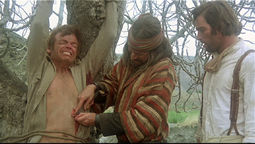 ejects them from town into the desert. Along the way to a new destiny they meet Chaco (Tomas Milian), who seems like a nice guy until he gets everyone stoned on booze and peyote, then proceeds to blow out Clem's kneecaps and rape Bunny while Stubby and Bud are tortured and left tied to the ground. The four manage to escape and resume their trip to the promised land, only to encounter something far different from what they expected. After a number of sacrifices and tragedies, fate finally allows events to come full circle as Stubby decides to seek revenge against Chaco.
ejects them from town into the desert. Along the way to a new destiny they meet Chaco (Tomas Milian), who seems like a nice guy until he gets everyone stoned on booze and peyote, then proceeds to blow out Clem's kneecaps and rape Bunny while Stubby and Bud are tortured and left tied to the ground. The four manage to escape and resume their trip to the promised land, only to encounter something far different from what they expected. After a number of sacrifices and tragedies, fate finally allows events to come full circle as Stubby decides to seek revenge against Chaco.
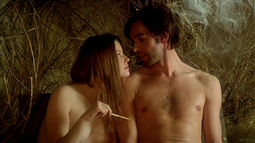 The back cover for Anchor Bay's DVD of Four of the Apocalypse promises the inclusion of footage deleted from all circulating prints of the film, with the reinstated dialogue in Italian with optional English subtitles. These scenes include the aforementioned Chaco torture routine as well as a greatly expanded version of Bunny's rape (though only the former contains subtitled dialogue). The only previous English language release in Japan looked watchable despite these studio-imposed cuts, but the DVD's quality is tremendously improved. Though detail is hampered by some of Salvati's soft focus compositions, particularly during the misty opening scene, the transfer looks as good as one could expect, with accurate color reproduction. The only significant debit is a tiny vertical line running through a few scenes near the right side of the screen, similar to the flaw in the negative of Fucli's The Black Cat. The film can also be played with its entire Italian language soundtrack, though alas no English subtitles are provided. The Italian track contains several notable variations from the English version, including the (thankful) absence of an opening narration.
The back cover for Anchor Bay's DVD of Four of the Apocalypse promises the inclusion of footage deleted from all circulating prints of the film, with the reinstated dialogue in Italian with optional English subtitles. These scenes include the aforementioned Chaco torture routine as well as a greatly expanded version of Bunny's rape (though only the former contains subtitled dialogue). The only previous English language release in Japan looked watchable despite these studio-imposed cuts, but the DVD's quality is tremendously improved. Though detail is hampered by some of Salvati's soft focus compositions, particularly during the misty opening scene, the transfer looks as good as one could expect, with accurate color reproduction. The only significant debit is a tiny vertical line running through a few scenes near the right side of the screen, similar to the flaw in the negative of Fucli's The Black Cat. The film can also be played with its entire Italian language soundtrack, though alas no English subtitles are provided. The Italian track contains several notable variations from the English version, including the (thankful) absence of an opening narration.
![]()